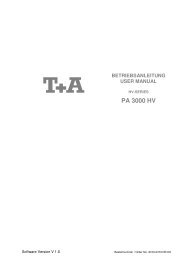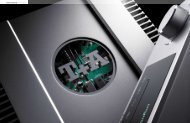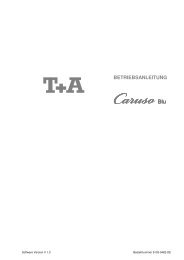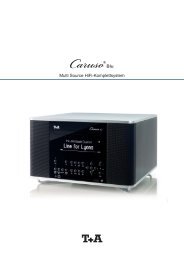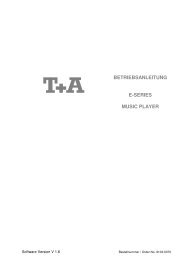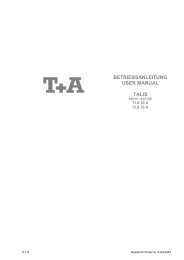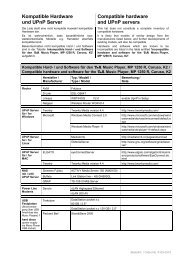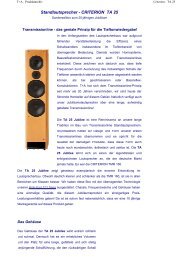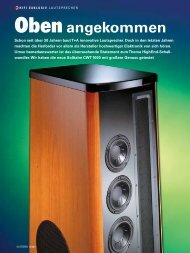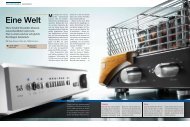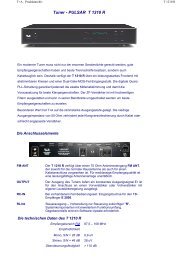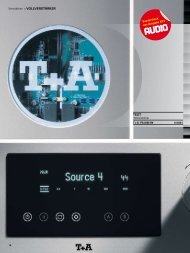REVIEWS - T+A Elektroakustik
REVIEWS - T+A Elektroakustik
REVIEWS - T+A Elektroakustik
Create successful ePaper yourself
Turn your PDF publications into a flip-book with our unique Google optimized e-Paper software.
<strong>REVIEWS</strong><br />
<strong>T+A</strong>’s<br />
home hub<br />
With the functionality of a server, a CD player, a<br />
tuner, a DAC and an amp, <strong>T+A</strong>’s latest could free<br />
up any equipment rack, says Richard Black<br />
T<br />
<strong>T+A</strong> E-SERIES<br />
MUSIC RECEIVER £2,690<br />
+A is one of those<br />
company’s that takes care<br />
not to make the products<br />
that others are making.<br />
Obviously in the fine details that’s<br />
true of most manufacturers, but here<br />
we’re talking about quite substantial<br />
differences. Music streamers are<br />
becoming quite familiar and the<br />
idea of the receiver is as old as the<br />
hills; <strong>T+A</strong> has brought these<br />
concepts together with a few other<br />
features to create an impressively<br />
flexible system that basically does<br />
everything you could want from a<br />
hi-fi system, except turning electrical<br />
signals into sound – you’ll still have<br />
to buy speakers (perhaps from<br />
RECOMMENDED<br />
<strong>T+A</strong>, which offers a few models) for<br />
that task.<br />
Many routes to the music<br />
Running down list of ways in which<br />
you might access music, the receiver<br />
offers CD (there’s a transport built<br />
in), FM radio and Digital radio. Now,<br />
if by that you mean DAB, then the<br />
answer’s ‘no’. However, unless you<br />
are among the last diehards with no<br />
internet connection, you’ll surely<br />
prefer internet radio which, in most<br />
cases, offers more choice in better<br />
quality than DAB, so make that a<br />
‘yes’ after all.<br />
Naturally, since the Receiver<br />
connects to the internet via your<br />
DETAILS<br />
PRODUCT:<br />
<strong>T+A</strong> E-Series Music<br />
Receiver<br />
ORIGIN:<br />
Germany<br />
TYPE:<br />
CD player/streamer/<br />
receiver<br />
WEIGHT:<br />
10kg<br />
DIMENSIONS:<br />
(WxHxD)<br />
440x120x390mm<br />
FEATURES:<br />
• CD transport<br />
• Ethernet and<br />
wireless server<br />
• FM tuner<br />
• USB connection<br />
to music player (inc.<br />
iPod)<br />
• 5x digital inputs (3<br />
electrical, 2 optical)<br />
• Digital output<br />
(electrical)<br />
• Headphone out<br />
(mini-jack, front<br />
panel)<br />
DISTRIBUTOR:<br />
Acoustic Brands<br />
Limited<br />
TELEPHONE:<br />
07917 431 280<br />
WEBSITE:<br />
taelektroakustik.<br />
de<br />
router, it can also get access to music<br />
stored on your computer network<br />
that’s accessible to a uPnP server, so<br />
that’s another source covered.<br />
Connect up with an Ethernet cable<br />
and you can play high-res files;<br />
wireless connection is also available<br />
but doesn’t guarantee higher-than-<br />
CD bitrates (though we did actually<br />
manage to play 24-bit/96kHz WAV<br />
files wirelessly).<br />
Portable music player? Yes, there<br />
are two USB-A sockets at the rear, for<br />
USB hard discs and portable players<br />
of all kinds, including Apple models.<br />
(That’s digital iPod connection, of<br />
course, being USB – analogue via<br />
USB is physically impossible so this<br />
way you know you are getting the<br />
bits, all the bits and nothing but the<br />
bits.) LP? This is the only flat ‘no’<br />
– but then you can buy a variety of<br />
very decent LP preamps for under<br />
£500, some for under £100, so it’s<br />
not hard to add this as an upgrade.<br />
The Receiver has three line-level<br />
analogue inputs, so you can also<br />
connect your cassette deck and<br />
open-reel recorder.<br />
Almost superfluously, there are five<br />
digital inputs. Obviously it’s great to<br />
be flexible, but we’re not sure we<br />
could imagine having that many<br />
sources. Freeview box, satellite<br />
72 DECEMBER 2011 www.hifichoice.co.uk
eceiver, DVD player, DAT, MiniDisc?<br />
Only the most encyclopaedic gear-<br />
head will ever run out here. There<br />
are also various ways of getting<br />
outputs, apart from the speaker<br />
terminals. There are ‘recording’ and<br />
‘line’ outputs, which are basically the<br />
same thing, plus ‘pre’, which tracks<br />
the volume control.<br />
In control<br />
It would be hard to control this lot<br />
without a fairly sophisticated user<br />
CONNECTIONS<br />
1<br />
Line-level analogue<br />
inputs and outputs<br />
1<br />
3<br />
2<br />
Digital output<br />
interface and, accordingly, there’s a<br />
large graphics display on the front of<br />
the Receiver, that shows up to three<br />
lines of text with the active line shown<br />
in larger type, plus various bits of<br />
ancillary information. That’s good,<br />
but we have reservations about how<br />
everything is controlled. Both front-<br />
panel and remote are rather confusing,<br />
with buttons requiring short or long<br />
presses for various functions and<br />
labelling that isn’t always as clear as<br />
one might wish. ‘SRC’? ‘SCL’?<br />
2<br />
3<br />
4<br />
Speaker outputs<br />
4<br />
TALKING<br />
POINT<br />
ONE OF THE longstanding<br />
arguments<br />
against receivers<br />
is that the various<br />
functions can<br />
interfere with each<br />
other electronically<br />
– basically, noise<br />
generated by one<br />
bit (such as the<br />
radio tuner head)<br />
may interfere with<br />
other bits. That’s<br />
certainly a valid<br />
point. Indeed, as<br />
Lothar Weimann<br />
points out in his<br />
answer (see p74)<br />
to our question<br />
about wired versus<br />
wireless LAN<br />
connection, it’s<br />
still an issue.<br />
But it’s becoming<br />
less of one as the<br />
years go by.<br />
Part of the<br />
reason for this is<br />
the decreasing<br />
physical size of<br />
circuit modules,<br />
which makes them<br />
less likely to radiate<br />
unwanted radio<br />
waves. The FM<br />
head in this unit<br />
is minute and the<br />
WLAN circuitry is on<br />
a tiny circuit board.<br />
But, perhaps,<br />
even more<br />
importantly,<br />
modern circuit-<br />
designing software<br />
allows designers<br />
to check on<br />
noise-generating<br />
potential and<br />
minimise it before<br />
even a prototype<br />
is constructed.<br />
And indeed, we<br />
were not aware<br />
of any ill effects<br />
from the Receiver’s<br />
multitudinous<br />
circuit blocks<br />
during our testing.<br />
5<br />
FM antenna connection<br />
on US-style F socket<br />
5<br />
<strong>T+A</strong> E-SERIES<br />
MUSIC RECEIVER £2,690<br />
Plentiful digital<br />
outputs<br />
The trouble is that we’ve been<br />
spoiled, as far as user interfaces<br />
are concerned, by the absolutely<br />
delightful Logitech Squeezebox (HFC<br />
351) with its full-colour touch screen.<br />
Having seen what’s possible we’re<br />
much more inclined to be intolerant<br />
of awkward controls and unclear<br />
labelling. This Receiver isn’t bad and<br />
it did (just) pass the test of basic<br />
operation without reference to the<br />
manual, but we could imagine it<br />
done better, especially at this price.<br />
Build quality is very good, with the<br />
satin-finish aluminium top and front<br />
being no surprise; you may raise an<br />
eyebrow at the use of plastic for the<br />
side panels, but this is, we reckon,<br />
rather a shrewd move. It’s a very<br />
nice-looking plastic, for a start, and it<br />
doesn’t mark easily, a strong point in<br />
“The concept is<br />
a winner and the<br />
performance never<br />
less than decent.”<br />
its favour compared with wood, for<br />
instance. Underneath the unit, feet<br />
are eschewed in favour of feltcovered<br />
ridges, which help the unit<br />
sit very securely on any surface.<br />
Sockets at the rear are very well<br />
protected by a substantial overhang<br />
from the top cover. Actually, that<br />
makes them basically impossible to<br />
access from the top, but we imagine<br />
most users of a device like this won’t<br />
be plugging and unplugging<br />
equipment all the time.<br />
Digital equality<br />
With so many options available, we<br />
tried to give each one a fair turn, but<br />
seemed to end up spending rather<br />
more time with computer-stored<br />
6<br />
6<br />
USB sockets for all<br />
kinds of devices<br />
www.hifichoice.co.uk DECEMBER 2011<br />
<strong>REVIEWS</strong><br />
73
<strong>REVIEWS</strong><br />
HIDDEN TECH<br />
3<br />
1<br />
4<br />
Torodial mains transformer<br />
for power amp section<br />
FM tuner section<br />
files. It’s not that they sounded<br />
dramatically clearer, nor that there<br />
was more choice that way, it’s just yet<br />
another illustration of how the fully<br />
connected life is making us all<br />
alarmingly lazy. That said, we’ll get<br />
up and change CDs happily enough if<br />
they sound better!<br />
But they don’t, in this case at least.<br />
Indeed, there’s no reason why they<br />
should, all else being equal. We store<br />
all our music in lossless format, so a<br />
properly functional digital connection<br />
should deliver them to the DAC at<br />
the heart of a unit in identical form<br />
to that read off CDs. Maybe there’s<br />
the occasional hint of bias towards<br />
one flavour (Ethernet, Wireless LAN,<br />
digital input, CD) or another, but in<br />
every case when we thought we<br />
spotted something it was so small<br />
and intangible that we ended up<br />
regarding them all as equal. The only<br />
one that seemed slightly below par<br />
RESULTS AT A GLANCE<br />
Excellent<br />
Above<br />
average<br />
Average<br />
Below<br />
average<br />
Poor<br />
1<br />
<strong>T+A</strong> E-SERIES<br />
MUSIC RECEIVER £2,690<br />
MAXIMUM<br />
USEABLE OUTPUT:<br />
96W (0.1% THD)<br />
into 8 ohms.<br />
In line with the<br />
manufacturer’s<br />
specifications<br />
4<br />
5<br />
2<br />
5<br />
THD@10W:<br />
(1kHz, 8 ohms)<br />
0.08%.<br />
Good distortion<br />
figure for this<br />
output level<br />
Switch-mode power supply<br />
for digital and control<br />
sections<br />
Digital input receiver<br />
and DAC circuits<br />
3<br />
6<br />
Analogue preamp board,<br />
with power amp board<br />
hidden underneath<br />
Microprocessor and<br />
control units<br />
was the optical digital input, which<br />
for some reason struck us as a touch<br />
subdued in the detail department,<br />
but even there it was pretty marginal.<br />
Detail would tend to be where one<br />
notices any change in sound, because<br />
this unit’s just so darn good at it. By<br />
any standards, its powers of analysis<br />
are prodigious and it can get right<br />
inside familiar recordings and bring<br />
out things one didn’t know were there.<br />
There’s something of a downside,<br />
though, in that the sound can<br />
sometimes seem a little clinical and<br />
detached. Searching for the root<br />
cause of that, we realised that the<br />
integration between bass and higher<br />
frequencies is not quite perfect. In<br />
turn, that’s down to a very slightly<br />
lazy quality to bass, which doesn’t<br />
quite have the energy and attack of<br />
midrange and treble. It’s not<br />
something one comes across very<br />
often and it’s not major, but it does<br />
FREQUENCY<br />
RESPONSE:<br />
20Hz-20kHz +/-<br />
0.4dB.<br />
Solid parity<br />
between channels<br />
CROSSTALK:<br />
@ 10kHz (L to R):<br />
-68dB; (R to L):<br />
-74B.<br />
Reasonable<br />
separation<br />
at 10kHz<br />
2<br />
DYNAMIC<br />
RANGE:<br />
90dB. Dynamic<br />
range is well<br />
maintained<br />
for such a<br />
busy system<br />
6<br />
TALKING QUESTION<br />
POINT TIME<br />
WE SPOKE TO<br />
Lothar Weimann,<br />
head of R&D at <strong>T+A</strong><br />
HFC: There are plenty<br />
of off-the-shelf Class<br />
D amp modules<br />
available. Why did<br />
<strong>T+A</strong> decide to build<br />
its own?<br />
LW: Simply<br />
because we could<br />
not find an offthe-shelf<br />
amp that<br />
really met all our<br />
requirements, so<br />
eight years ago<br />
we developed<br />
our own Class-D<br />
technology. Our<br />
approach differs<br />
in many ways<br />
from the Class-D<br />
mainstream.<br />
The distortion<br />
spectrum of our<br />
amps is very<br />
similar to a good<br />
analogue amp.<br />
We also use a<br />
traditional torodial<br />
transformer power<br />
supply instead<br />
of switch-mode<br />
PSUs, because<br />
transformers don’t<br />
show hard current<br />
limiting.<br />
HFC: Why is there no<br />
USB socket<br />
to connect to<br />
a computer?<br />
LW: We prefer S/<br />
PDIF for digital<br />
audio signals<br />
because of<br />
better noise and<br />
interference<br />
isolation between<br />
computer and<br />
audio equipment.<br />
When needed, an<br />
external USB/S/<br />
PDIF dongle can be<br />
used.<br />
HFC: Apart from<br />
hi-res files, are there<br />
any advantages<br />
to wired LAN<br />
connection that<br />
would justify the<br />
trouble of running<br />
wires around the<br />
place?<br />
LW: When using<br />
a wired LAN<br />
connection we<br />
switch off all the<br />
RF components<br />
in our devices<br />
resulting in less<br />
high-frequency<br />
interference.<br />
Running a W-LAN<br />
means more work<br />
for the processor,<br />
resulting in less<br />
idle states and in<br />
even more digital<br />
interference.<br />
A wired LAN<br />
means higher<br />
performance,<br />
higher bandwidth<br />
have some effect on one’s perception<br />
of a whole musical event.<br />
All the same, we found plenty to<br />
like in this unit’s presentation. As is<br />
often the way, it seems more at home<br />
with some musical styles than others<br />
and we found it most successful with<br />
the highly structured world of<br />
classical music, but also very<br />
convincing in big-scale rock. Some<br />
folk music seemed at the other<br />
extreme and it didn’t do very much<br />
for heavily processed contemporary<br />
pop music either. At best, though, the<br />
Receiver created some very lifelike<br />
symphonic and operatic sounds, as<br />
well as truly epic-scale glam and<br />
prog rock.<br />
Incidentally, FM reception is really<br />
rather special. The Receiver needs<br />
a pretty strong radio signal but,<br />
given that, it has very clean and<br />
clear sound that recalls some of the<br />
better FM tuners we’ve reviewed<br />
over the years. All the same, we’d<br />
prefer internet connection for many<br />
major stations.<br />
The sum of its parts<br />
Summing up a unit like this is bound<br />
to be hard, principally because of the<br />
lack of comparisons. If you tried to<br />
get together separate CD player,<br />
server and radio sources and put<br />
them together with an amp of similar<br />
rating, you’d have trouble assembling<br />
anything of comparable sonic<br />
attainment, and it would obviously<br />
waste a lot more space in your<br />
home and probably require more<br />
remote controls.<br />
On that basis, value is very good,<br />
but we still have some reservations,<br />
looking at the issue of control and<br />
ergonomics as well as listening to<br />
that slightly disjointed bass. In the<br />
end, though, the mere concept is<br />
quite a winner and performance<br />
is never less than decent, so we’ll<br />
give the E-Series Music Receiver<br />
a warm welcome, with compliments<br />
to <strong>T+A</strong> for a job well done.<br />
OUR VERDICT<br />
SOUND QUALITY<br />
VALUE FOR<br />
BUILD QUALITY<br />
FEATURES<br />
OVERALL<br />
LIKE: Excellent bass<br />
extension; clean midrange<br />
and treble<br />
DISLIKE: Bass doesn’t<br />
always have the attack of<br />
midrange and treble<br />
WE SAY: Few single units<br />
offer as many features.<br />
Attractive on both practical<br />
and sonic grounds<br />
74 DECEMBER 2011 www.hifichoice.co.uk



